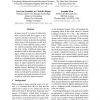Free Online Productivity Tools
i2Speak
i2Symbol
i2OCR
iTex2Img
iWeb2Print
iWeb2Shot
i2Type
iPdf2Split
iPdf2Merge
i2Bopomofo
i2Arabic
i2Style
i2Image
i2PDF
iLatex2Rtf
Sci2ools
112
click to vote
INLG
2010
Springer
2010
Springer
Finding Common Ground: Towards a Surface Realisation Shared Task
In many areas of NLP reuse of utility tools such as parsers and POS taggers is now common, but this is still rare in NLG. The subfield of surface realisation has perhaps come closest, but at present we still lack a basis on which different surface realisers could be compared, chiefly because of the wide variety of different input representations used by different realisers. This paper outlines an idea for a shared task in surface realisation, where inputs are provided in a common-ground representation formalism which participants map to the types of input required by their system. These inputs are derived from existing annotated corpora developed for language analysis (parsing etc.). Outputs (realisations) are evaluated by automatic comparison against the human-authored text in the corpora as well as by human assessors. 1 Background When reading a paper reporting a new NLP system, it is common these days to find that the authors have taken an NLP utility tool off the shelf and reused ...
| Added | 13 Feb 2011 |
| Updated | 13 Feb 2011 |
| Type | Journal |
| Year | 2010 |
| Where | INLG |
| Authors | Anja Belz, Mike White, Josef van Genabith, Deirdre Hogan, Amanda Stent |
Comments (0)

